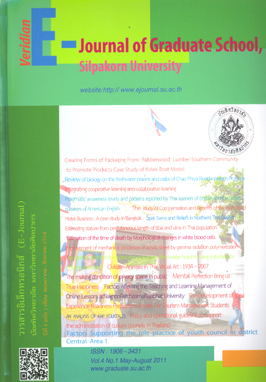การฟื้นฟูตลาดเก่าในเมืองไทย
Main Article Content
บทคัดย่อ
บทคัดย่อ
ในเมืองไทยนั้นมีตลาดเก่าอยู่หลายแห่ง งที่เป็นตลาดบก หรือตลาดน้ำ ตลาดเหล่านี้ได้สูญหายไป พร้อมๆกับการพัฒนาของเมืองที่เปลี่ยนมาใช้ถนนเป็นเส้นทางขนส่งหลักร้านค้าเรือนไม้หลายหลังถูกรื้อ และ แทนที่ด้วยตึกอาคารพาณิชย์คอนกรีต เพื่อสร้างผลตอบแทนทางธุรกิจที่ดีกว่า
อย่างไรก็ตาม ยังมีตลาดเก่าหลายแห่งที่ยังคงอยู่ แต่ส่วนใหญ่ได้ปรับให้เป็นสถานที่ท่องเที่ยว เพื่อตอบสนองกระแสการท่องเที่ยวเชิงวัฒนธรรม บางตลาดอย่างเช่น ตลาดน้ำอัมพวา และตลาดน้ำ ดำเนินสะดวกนั้น ประสบความสำเร็จอย่างยิ่งในการสร้างรายได้ให้กับพื้นที่ แม้ว่าอาจมีประเด็นในเรื่องของ ความแท้ (authenticity) หรือเอกลักษณ์ของพื้นที่ (core identiy) โดยเฉพาะในเรื่องของ ‘ความแท้ (authenticity)’ นั้น ถูกคุกคามโดยธุรกิจท่องเที่ยวที่เน้นหนักในด้านการสร้างรายได้เชิงเศรษฐกิจ มีการ สร้างสินค้าทางวัฒนธรรมขึ้นมาใหม่ ซึ่งอาจจะไม่ได้เป็นวัฒนธรรมของพื้นที่เพื่อตอบสนองนักท่องเที่ยว
ดังนั้น แม้ว่าการท่องเที่ยวจะมีบทบาทสำคัญในการรักษาพื้นที่มรดกทางวัฒนธรรมเอาไว้ โดย การให้ประโยชน์ในเชิงพาณิชย์ แต่ก็ให้ผลในด้านลบได้เช่นกัน เพราะการท่องเที่ยวก็สามารถลด ‘คุณค่า’ ของสถานที่ได้ หากขาดการจัดการและการควบคุมที่ดี ดังนั้นองค์ความรู้ในด้านการฟื้นฟูมรดกทางวัฒนธรรม จึงเป็นสิ่งที่จำเป็นอย่างยิ่ง ซึ่งเป็นความรู้ที่สามารถนำไปใช้กับการฟื้นฟูตลาดเก่า หรือชุมชนทางวัฒนธรรม อื่นๆในเมืองไทยได้ ดังนั้นเป้าหมายของงานวิจัยนี้ ก็เพื่อให้แนวทางในการพัฒนาตลาดเก่าในเมืองไทย ให้ได้รับการ ฟื้นฟูและอนุรักษ์ด้วยวิธีการที่ถูกต้อง โดยตลาดเก่านั้นจะต้องสามารถสร้างประโยชน์ในเชิงพาณิชย์ พร้อมๆ กับการรักษาไว้ซึ่ง “ความแท้ (authenticity)” ของสถานที่ ซึ่งจะต้องบริหารจัดการโดยคนในชุมชน สำหรับ วัตถุประสงค์การวิจัยนี้ เพื่อหาวิธีการและกลยุทธ์ในการฟื้นฟูตลาดเก่าที่มีประสิทธิภาพ เพื่อเป็นต้นแบบใน การพัฒนาตลาดเก่าอื่นๆในเมืองไทยต่อไป
จากการวิจัย พบว่าแนวทางในการฟื้นฟูตลาดเก่านั้น จะต้องมีกรอบดำเนินการ 5 ประการ คือ (1) มุ่งด้านวัฒนธรรม, (2) คิดและทำอย่างมีกลยุทธ์, (3) ให้ความสำคัญกับพื้นที่สาธารณะ, (4) การมีส่วน ร่วมของชุมชน และเครือข่าย และ (5) การปรับใช้ใหม่ (New uses)
สิ่งที่ท้าทายในการฟื้นฟูก็คือการกำหนดกระบวนการฟื้นฟูและวิธีปฏิบัติที่จะส่งผลการพัฒนานั้น เป็นการพัฒนาที่ยั่งยืน (sustainable development) เพื่อที่จะสร้างประโยชน์แก่คนในชุมชน, เศรษฐกิจ ชุมชน และสภาพแวดล้อมที่ดีในระยะยาว
Abstract
Many of the charming old markets in Thailand, both terrestrial and water markets, have disappeared in recent years. Their loss was mainly caused by urban development. Road was the main mode of transportation. Old wooden shop houses were replaced by concrete commercial buildings to generate more economic benefits to owners.
Some old markets still exist. Most of them are trying to transform themselves into tourism places in response to the growing trend of cultural tourism. Some of them, such as Amphawa and Damnoen Saduak floating markets, are very successful in generating income for communities. But even in such places there are many issues around the retention of authenticity and core identity of the places that need to be considered. Authenticity is threatened by the tourism process’ emphasis on maximizing economic outcomes; cultural objects and cultural expressions are commodified to suit tourists.
Tourism can be a powerful force in maintaining heritage places by generating income from tourism spending. But on the negative side, tourism can reduce the value of places as well if it is not adequately controlled and properly managed
Therefore, know-how for revitalization of the places is truly necessary which can also be applied to other old markets or cultural heritage communities in Thailand. The goal of this study is to provide revitalization and conservation guideline for the old markets in Thailand. They are conserved in a proper way, can generate economic benefits to the community while safeguarding authenticity. Revitalization is led and managed by the local community. The objective is set to find out the proper actions and strategies for old markets revitalization. It would be the prototype for the development of other old markets in Thailand.
From the study, the revitalization of the old markets requires five themes as a framework for developing clear and practical guidance. They are (1) Cultural Approaches, (2) Think and Act Strategically, (3) Public Domain, (4) Community Involvement & Partnership and (5) Diversity – New Uses
The challenge of revitalization is to identify the actions and underlying processes that would be necessary to deliver regeneration at the strategic level under sustainable development to realize social, economic and environmental benefits.

